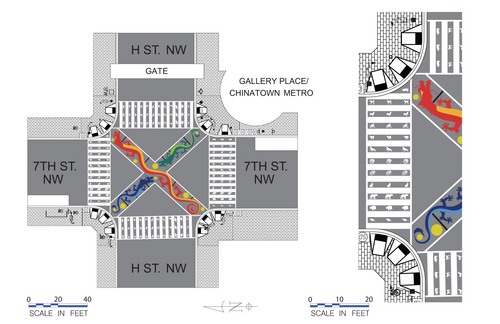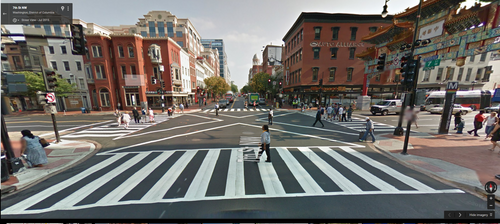Dragons and zodiac symbols will decorate Chinatown’s streets
Six years ago, the intersection of 7th and H Streets NW, in Chinatown, became a Barnes Dance— an intersection where the traffic lights in all directions turn red at the same time so people can cross the street at any angle they want. It continues to make walking in Chinatown a bit easier, and it’s about to get an unusually decorative paint job.
The name “Barnes Dance” comes from Henry Barnes, a traffic engineer who popularized the concept in the USA in the 1940s. Also called Pedestrian Scrambles, Barnes Dances can be found all over the world. There were a number of them in DC until the late 1980s, when they were replaced with normal intersections. In 2010, the Barnes Dance returned to DC, at 7th and H.
Last year, the city decided to commission an artist to paint the diagonal lines that connect the four corners of intersection to be more distinct and unique. The city picked a design by Charles Bergen Studios that features dragons and lamps that allude to the neighborhood’s history of hosting parades for Chinese New Year, along with the 12 animals used as symbols for the Chinese Zodiac. They’ll go in on the crosswalk in the next few weeks.
All this got me thinking: Does work that will make the diagonal crossings more visible mean that the Barnes Dance hasn’t been working like it should? Is our Barnes Dance unique? Who uses DC’s Barnes Dance, and might we get another in the future?
According to District Department of Transportation Pedestrian Program Coordinator George Branyan, 7th and H itself sees a lot of pedestrians. Its busiest time is in the afternoon, when the 4000 or so pedestrians who cross each hour outnumber cars two to one.
According to Branyan, a key difference between DC’s Barnes Dance and others around the world is that crossing the street on foot with a green light isn’t prohibited. Restricting crossing like that, which he said is common, would overcrowd the sidewalks and lead to delays for pedestrians in Chinatown.
DDOT’s pedestrian count data doesn’t actually suss out who is crossing diagonally versus who is crossing purely north-south or east-west. Branyan said that his own observations made him think about 10-20% of people do cross diagonally when available.
Chinatown is it for now
When I asked Branyan whether DDOT has any plans for future Barnes Dance intersections, he said his agency has looked at a few other possible locations, but that there aren’t any specific plans. He said the reason was that for a Barnes Dance to work properly, conditions have to be “just right,” like an intersection that doesn’t have all that many cars that want to make turns and enough people on foot who want to go in different directions, for example. Otherwise, you run the risk of delaying things for everyone.
It looks like the Barnes Dance in Chinatown is working like it’s supposed to, but that’s it for now. If you have any good candidates for where the Washington area’s next Barnes Dance should, list them in the comments!


